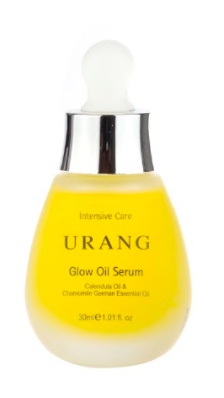
Glow Oil Serum
Ingredients overview
Highlights
Skim through
| Ingredient name | what-it-does | irr., com. | ID-Rating |
|---|---|---|---|
| Helianthus Annuus (Sunflower) Seed Oil | emollient | 0, 0 | goodie |
| Simmondsia Chinensis (Jojoba) Seed Oil | emollient | 0, 0-2 | goodie |
| Prunus Amygdalus Dulcis (Sweet Almond) Oil | emollient | 0, 1-3 | goodie |
| Calendula Officinalis Flower Oil | perfuming | ||
| Citrus Nobilis (Mandarin Orange) Oil | icky | ||
| Tocopherol | antioxidant | 0-3, 0-3 | goodie |
| Citrus Aurantium Amara (Bitter Orange) Flower Oil | icky | ||
| Chamomilla Recutita (Matricaria) Flower Oil | soothing | goodie |
URANG Glow Oil SerumIngredients explained
Sunflower does not need a big intro as you probably use it in the kitchen as cooking oil, or you munch on the seeds as a healthy snack or you adore its big, beautiful yellow flower during the summer - or you do all of these and probably even more. And by even more we mean putting it all over your face as sunflower oil is one of the most commonly used plant oils in skincare.
It’s a real oldie: expressed directly from the seeds, the oil is used not for hundreds but thousands of years. According to The National Sunflower Association, there is evidence that both the plant and its oil were used by American Indians in the area of Arizona and New Mexico about 3000 BC. Do the math: it's more than 5000 years – definitely an oldie.
Jojoba is a drought resistant evergreen shrub native to South-western North America. It's known and grown for jojoba oil, the golden yellow liquid coming from the seeds (about 50% of the weight of the seeds will be oil).
At first glance, it seems like your average emollient plant oil: it looks like an oil and it's nourishing and moisturizing to the skin but if we dig a bit deeper, it turns out that jojoba oil is really special and unique: technically - or rather chemically - it's not an oil but a wax ester (and calling it an oil is kind of sloppy).
The emollient plant oil that comes from almonds. Similar to other plant oils, it is loaded with skin-nourishing fatty acids (oleic acid - 55-86% and linoleic acid 7-35%) and contains several other skin goodies such as antioxidant vitamin E and vitamin B versions.
It's a nice, basic oil that is often used due to its great smoothing, softening and moisturizing properties. It's also particularly good at treating dry brittle nails (source).

The essential oil coming from the whole plant of the Mandarin Orange. In general, the main component of citrus oils is limonene, a super common fragrant ingredient that makes everything smell nice (but counts as a frequent skin sensitizer). The majority of the essential oil is in the peel, but the leaf also contains some with slightly different chemical composition.
Both the peel and the leaf oil contains some phototoxic compounds (the leaf oil contains methyl-N-methyl anthranilate), so it's a good idea not to use Mandarin Orange Oil containing products during the day.
- Primary fat-soluble antioxidant in our skin
- Significant photoprotection against UVB rays
- Vit C + Vit E work in synergy and provide great photoprotection
- Has emollient properties
- Easy to formulate, stable and relatively inexpensive
The essential oil coming from the flowers of bitter orange (which is the sister of the sweet orange we all know and eat). It contains several fragrance components including linalool (around 30%) and limonene (around 10%) and has a lovely sweet smell.
As it's an essential oil with lots of fragrant components, be careful with it if your skin is sensitive.
The essential oil coming from the German Chamomile. It's loaded with the famous anti-inflammatory agent, bisabolol (approx. 50%) and contains 5% of soothing, antiallergic and blue color giving chamazulene. It also contains about 120 other things, including 28 terpenoids and 36 flavonoids (including some antioxidants like quercetin).
As for skincare, the essential oil is used mainly for it's anti-inflammatory and soothing properties.
You may also want to take a look at...
| what‑it‑does | emollient |
| irritancy, com. | 0, 0 |
| what‑it‑does | emollient |
| irritancy, com. | 0, 0-2 |
| what‑it‑does | emollient |
| irritancy, com. | 0, 1-3 |
| what‑it‑does | perfuming |
| what‑it‑does | antioxidant |
| irritancy, com. | 0-3, 0-3 |
| what‑it‑does | soothing |





